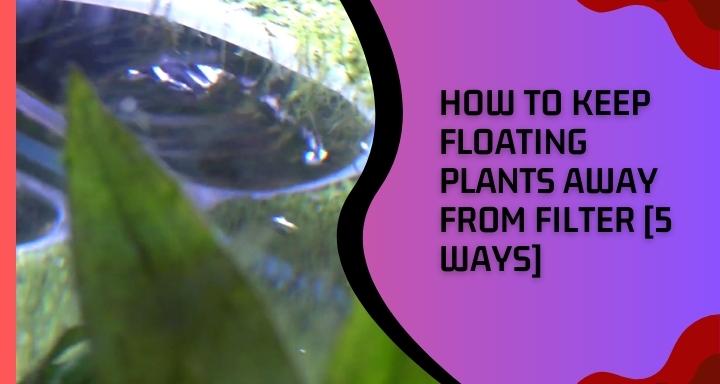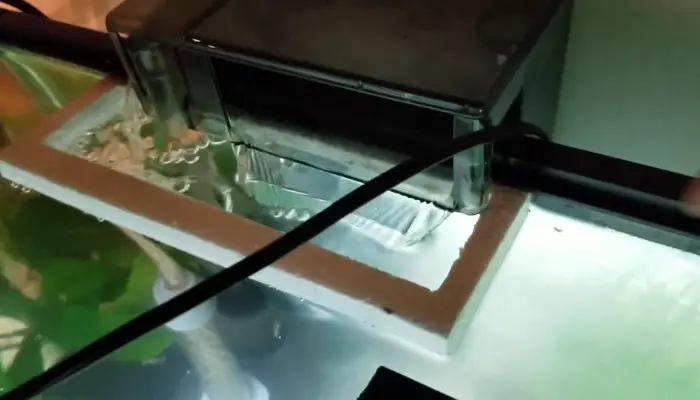
Floating aquatic plants are the cherry on top of your aquarium journey. Many people prefer keeping the tank vividly beautiful with such additions.
Let me tell you, I was also spellbound with such plants until they started messing up with my aquarium filters lately. As you know such filters are quite intricate in structure and hence need to be handled more delicately. That’s why when these plants keep getting into filter parts, it becomes quite hard to maintain.
Just like others are in love with floating greens but worried about their filters getting jammed by these? I got your back. In this article, I will share some methods that helped me a lot to keep floating plants away from the filter
So, let’s bring the show on the road.
How to Keep Floating Plants Away From the Filter
1. Using Intake Sponge

Keeping floating plants with a hob filter is quite challenging. But protecting your filter intake can help you in this to a great extent.
This can also be remarked as a pre-filter to prevent your plants from getting directly into the filter. Normally some sponges are shaped in a cylinder form to cover the main filter of the aquarium. You might have also seen them in some large reef tanks.
Let me tell you how it works. Generally, the intake tube of your filter can draw down plant parts, some sand, and even your little fish. To prevent such action, a pre-filter works finely as this acts as a floating plant barrier. By using this you can also save your fish too.
2. Adapting an Intake Covering
As the filter intake is located close to the surface, floating duckweeds get stuck in them more often. I can still recall my initial days with my aquarium when the only idea that stroked me was to cover up the intake opening. It’s a quick alternative to the pre-filter.
The opening in the intake tube tends to get clogged by plant parts and other debris. To prevent this, coverings can act as a great barrier. Normally, pantyhose or net stalking is used to cover the filter intakes.
No doubt you can use this method in an emergency. But after 4 whole years of dealing with aquariums, I would suggest you not go with it too often as investing in pre-filters is much more reliable.
3. Separating Plants by the Floating Ring

It’s a quite popular and easy method to keep floating plants in one place. If you are wondering how to keep duckweed away from the filter, some self-made rings can be an excellent option.
Now you might be thinking of how to make such rings. Let me tell you that the airline tubes that connect the different aquarium equipment can help you with this. You can glue together multiple of them to form a floating plant ring.
In my freshwater aquarium, I use this method most of the time. It’s not that tricky to make. All you’ll need is some sealant, airline tubing, and universal tube connectors. You don’t even need too much of the tubing. The last time I had to use only 2 feet of it for my medium-sized aquarium. Make sure to place it not only around the plants but also around the hob outlet.
Try to purchase some hard plastic tubing. Acrylic ones are quite useful in such cases. These are durable and won’t make your aquarium look clumsy.
Most of the time such rings are allowed to move freely on your aquarium surface. But if you are planning to keep your floating plants away from the filter, you can place the ring right beside the filter opening where water keeps swirling. This will also help to save your floating plants away from filter waterfalls.
4. Utilizing Fishing Line
Fishing lines help to keep aquatic plants within the desired depth in your aquarium. Even sometimes grounded plants can be unfastened and keep moving haphazardly. With the flow of water current, they can be stuck to the aquarium filter.
To prevent this, fishing lines act as a fence. You can even incorporate some suction cups that will help to stick the lines with the aquarium walls. You can find some tiny holes in such cups. Just insert the fishing strings inside those holes and attach them to the walls. All of these are transparent, so they won’t ruin the beauty of your tank.
This method is effective for plants like water sprite, miniature water lettuce, and hornwort. It is suggested to place such lines at a depth of 4 centimeters from the top surface.
5. Investing in a Barrier
I’ve seen many people struggling with keeping the mechanical filters clean. It’s even a bit tricky to maintain floating plants with a sponge filter. Such plants are a major reason why your filters are getting worn off too early.
You can pick the plants like water wisteria, pygmy water lettuce, and Rotala indica as they can resist the strong water current. Trimming off the gravel-grounded plants helps a lot in preventing the tearing of foliage by reducing the chance of getting stuck into the filter.
If you are planning to keep floating plants in an aquarium without any hassle, market-bought barriers never fail. Most of these are self-adjusting and excellent to keep different floating plants in one place.
FAQs
Are Floating Plants Bad For Aquariums?
Actually no. Floating plants are quite beneficial as they can enrich your aquarium with a better oxygen supply for your corals and fishes. The main problem with them is the haphazard movement can create a blockage to the filter tubes. As you got to know how to resolve this issue, now you can happily grow them in your tank.
Do Aquatic Plants Serve The Purpose Of A Filter?
No doubt plants are great to maintain the water quality of your aquarium. They can absorb the excess ammonia and CO2 in the tank. But to clean the waste generated from biological actions you need to set up some kind of mechanical filtration in your tank.
Do The Fishes Like To Eat The Floating Plants?
Fishes use floating plants for nibbling. Occasionally they can consume such plants. It depends on the nature and type of your fish. Some omnivores can gulp up the whole plant.
Conclusion
You might have been keeping floating plants away from filters for ensuring better water quality and beautification also. To keep them in one place and save your filters you can adopt any of the methods that’s easy for you.
In this article, I tried my best to find you something that will help you in the long run. Let me know how things are going and also what would you like to hear from me next. You can reach me anytime in the comment section.
- Top 15 Freshwater Aquarium Plant Ideas for a Lush, Green Tank - November 9, 2024
- Top 13 Freshwater Aquarium Layout Ideas for a Beautifully Organized Tank - November 9, 2024
- 14 Stunning Rustic Freshwater Aquarium Ideas for a Tranquil Environment - November 9, 2024
